Ballyhaunis, nestled in County Mayo, Ireland, boasts a rich historical tapestry that stretches back millennia. The area around the town is steeped in archaeological significance, offering glimpses into Ireland’s prehistoric and early Christian past.
Contents
Origins and Early History
Prehistoric and Early Christian Sites
The landscape surrounding Ballyhaunis is dotted with an impressive concentration of megalithic monuments, making it one of the most archaeologically rich areas in the West of Ireland. These ancient structures provide tangible links to our distant ancestors and their ways of life.
Notable prehistoric sites include:
- Court Tomb at Cappagh, Tooreen (3400 – 1800 BC): This Neolithic burial site represents some of the earliest farming communities in Ireland.
- Wedge Tomb at Greenwood (1900 – 1400 BC): Dating from the Late Neolithic to Early Bronze Age, this type of tomb is characteristic of the region.
- Numerous ringforts: These circular fortified settlements, likely from the Early Medieval period, are scattered across the landscape.
- Crannogs at Island Lake and White Lake: These artificial islands were used as dwellings from prehistoric times through the Middle Ages.
- Fulachta fiadha: These ancient cooking sites, often found near water sources, date back to the Bronze Age.
The area also boasts evidence of early Christian activity:
- Ogham Stones at Island and Tullaghaun (c. 400 AD): These inscribed stones represent some of the earliest forms of writing in Ireland.
- Several early church sites: While specific details are not provided, the presence of these sites indicates the spread of Christianity in the early medieval period.
A remarkable recent discovery was a 4,000-year-old dugout boat found in nearby Aughamore, further emphasizing the area’s rich archaeological heritage.
Norman Settlement
The arrival of the Normans in the 12th and 13th centuries marked a significant shift in the region’s history. While specific details about Norman settlement in Ballyhaunis itself are scarce in the provided information, we can infer some details:
- There are references to a Fitzgerald fortress and manor on Abbey Hill, suggesting Norman presence and control in the area.
- The Nangle family, who later adopted the name Costello, played a significant role in the region. They were likely of Norman descent and became important patrons, later endowing the Augustinian friary.
- The establishment of manors and fortresses by Norman lords typically encouraged the growth of settlements around them, potentially contributing to the early development of Ballyhaunis.
While the exact founding date of Ballyhaunis as a town is unclear, it’s likely that Norman influence played a role in shaping the early settlement that would eventually grow into the town we know today. The Norman period set the stage for the later founding of the Augustinian friary in the 14th century, which would become a pivotal moment in Ballyhaunis’s history.
Founding of the Augustinian Friary
Establishment in 1348
The founding of the Augustinian Friary in Ballyhaunis marks a pivotal moment in the town’s history. According to local tradition, the friary, often referred to as St. Mary’s Abbey, was established in 1348. This date, however, is not without some debate, as some sources suggest it may have been founded around 1430.
The friary was founded by Jordan Dubh Mac Costello, a member of the influential Costello family (formerly known as the Nangle family). The Costellos, who were of Norman descent, had become significant patrons in the area and their endowment of the friary demonstrates their power and religious devotion.
The Augustinians were given approximately 150 acres of land, known as Abbey Quarter, on which to establish their community and farm for their own use. This generous grant provided the friars with a sustainable base from which to carry out their religious and community work.
Role in Town’s Development
The establishment of the Augustinian Friary played a crucial role in the development and growth of Ballyhaunis. It’s widely accepted that the town grew up around the friary, with the presence of a religious institution attracting settlers, traders, and pilgrims, forming the nucleus of a growing community. The friary became a significant spiritual center for the region, drawing people from far and wide who came to petition the priests, have their intentions included in Masses, and seek spiritual guidance.
The Augustinians also played a vital role in education, teaching reading, writing, and other subjects, providing educational opportunities that were otherwise scarce in medieval Ireland. They were known for teaching good farming practices as well, helping to improve agricultural productivity in the area. As a mendicant order, the Augustinians lived partly on the charity of local people, creating a strong bond between the friars and the community, with the friars often providing social services in return.
Despite periods of suppression, particularly during the Reformation and Cromwellian era, the Augustinian presence in Ballyhaunis provided a sense of continuity. The friary was revived during the 1641 insurrection and continued to play a significant role in town life well into the modern era. The friary, with its architectural features like the 15th-century doorway and window, became an important part of Ballyhaunis’s cultural and historical heritage.
The Augustinian Friary remained a central institution in Ballyhaunis for over 650 years. Even after the Augustinians left in 2002 due to falling vocations, the friary’s legacy continues to shape the town’s identity. The property was transferred to the Ballyhaunis Abbey Trust, ensuring its continued significance in community life. The founding of the Augustinian Friary in 1348 can thus be seen as the true beginning of Ballyhaunis as we know it today, playing a crucial role in the town’s spiritual, educational, social, and economic development over the centuries.
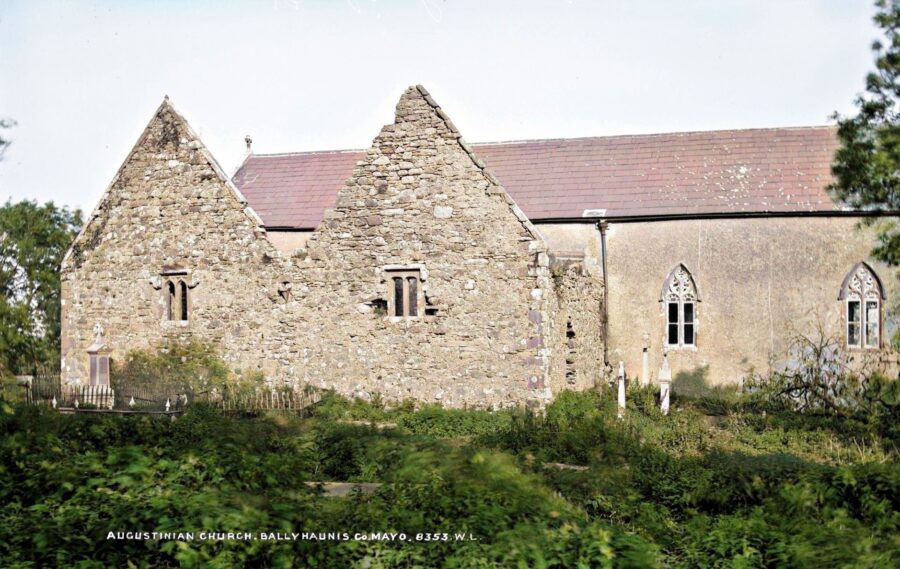
Growth of the Town (15th-18th centuries)
Development around the friary
Following the establishment of the Augustinian Friary in the mid-14th century, Ballyhaunis gradually evolved from a small settlement into a more substantial town. This growth was largely centered around the friary, which acted as a focal point for religious, social, and economic activity.
The friary continued to attract pilgrims and worshippers, contributing to the town’s population and importance in the region. The presence of the friars and their agricultural activities likely stimulated local trade and crafts, turning Ballyhaunis into an economic hub. The Augustinians’ role in education would have drawn people to the area, potentially including students and scholars, further enhancing the town’s reputation and population.
Architectural development played a significant role in the town’s growth. The expansion and renovation of the friary over time, including the addition of features like the 15th-century doorway and window, would have required skilled craftsmen, potentially leading to a growth in the local population. These artisans might have settled in the area, contributing to the town’s development and diversification of skills.
While specific details are scarce, the continued presence of Norman lords, such as the Costello family, likely contributed to the town’s development through their patronage and administrative structures. Their influence would have shaped the political and economic landscape of Ballyhaunis, potentially attracting more settlers and fostering growth.
This combination of religious significance, economic activity, educational opportunities, architectural development, and Norman influence collectively drove the transformation of Ballyhaunis from a small settlement to a thriving town over the centuries following the friary’s establishment.
Market Town Status
Ballyhaunis’s growth led to its emergence as a market town, a status that was crucial for its economic development and regional importance. While the exact date of Ballyhaunis’s first market is unclear, we know that by the mid-18th century, the town had established regular markets. In 1751, William Knox applied for a patent to hold markets and fairs in Ballyhaunis, indicating that the town had reached a significant size and economic importance by this time.
By 1802, as recorded in the Statistical Survey of County Mayo, Ballyhaunis had established fairs for cattle, held four times a year: on June 1, July 2, September 22, and October 29. Interestingly, the same survey notes that Ballyhaunis did not have a designated market for grain at that time, suggesting that cattle trading was the primary focus of its market activities.
The regular markets and fairs brought traders and buyers from surrounding areas, boosting the local economy and further cementing Ballyhaunis’s status as a regional center. This growth of market activities likely led to improvements in local infrastructure, such as roads and public spaces, to accommodate the influx of people and goods on market days.
Market days were not just economic events but important social occasions, bringing people together from the town and surrounding rural areas, and potentially influencing local culture and traditions. While specific details about the town’s growth during this period are limited, the establishment of regular markets and fairs by the 18th century clearly indicates that Ballyhaunis had developed into a significant local center.
This growth laid the foundation for the town’s further expansion in the 19th and 20th centuries, setting the stage for its emergence as an important market and later industrial town in Mayo. The evolution of Ballyhaunis from a small settlement to a bustling market town reflects the broader economic and social changes occurring in rural Ireland during this period.
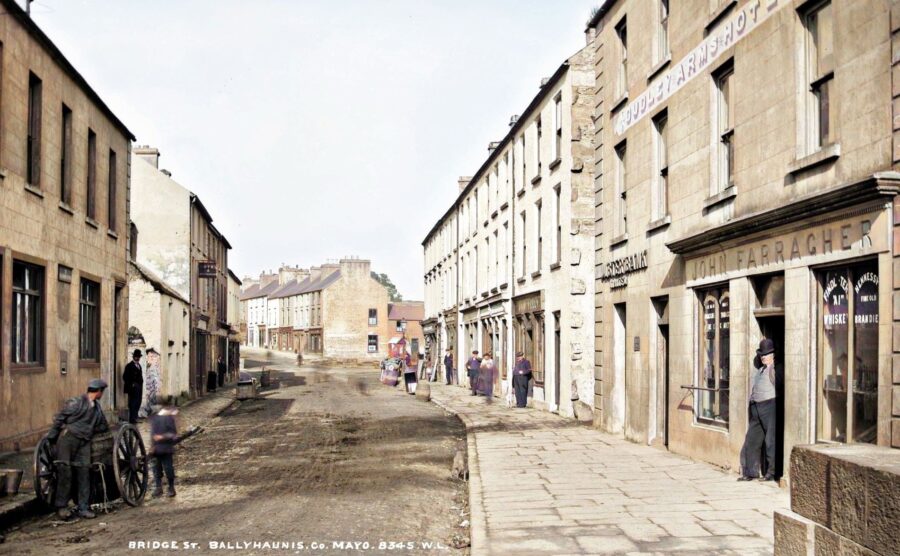
19th Century Developments
The 19th century brought significant changes to Ballyhaunis, particularly in terms of infrastructure and education. These developments helped to modernize the town and connect it more closely with the wider world.
Railway Arrival in 1861
The arrival of the railway in Ballyhaunis in 1861 was a transformative event for the town. Ballyhaunis railway station opened on October 1, 1861 (though some sources cite September 9, 1861), as part of the broader expansion of Ireland’s rail network in the mid-19th century. This new connection significantly boosted Ballyhaunis’s economy, providing easier access to markets for local produce and goods, particularly benefiting the town’s established cattle trade.
The station served as a crucial link on the Dublin to Westport rail service, improving travel options for locals and bringing more visitors to the area. Its importance grew further following the reported apparition at Knock in 1879, as Ballyhaunis station saw an increase in pilgrim traffic, serving as a stop for those traveling to the nearby shrine.
The presence of the railway likely spurred further development in Ballyhaunis, attracting businesses and potentially new residents drawn by improved transportation links. The railway’s lasting importance to the town is evidenced by the celebration of the station’s 150th anniversary in 2011, marked by a special edition of the local Annagh Magazine.
This railway connection not only improved Ballyhaunis’s economic prospects but also connected it more closely to the wider world, influencing its development and character in the decades that followed. It stands as a testament to the transformative power of infrastructure improvements in rural Ireland during the 19th century.
Schools and Education
The 19th century brought significant developments in education to Ballyhaunis, following the establishment of the national school system in Ireland in 1831. By 1832, records show a school in Ballyhaunis with a teacher named Laurence Groarke, housed in a modest one-story thatched building with a clay floor and four windows, measuring 40′ x 14′ and accommodating 140 pupils.
As the town grew, so did its educational facilities. On July 12, 1865, a new National School was officially opened opposite the Friary cemetery, a thatched building measuring 32 feet in length and 11 feet 6 inches in breadth. By 1875, the school staff had expanded to include a Principal (P.J. Heavey), an Assistant, and two Monitors, indicating growth in both student numbers and educational provision.
Further expansion came on April 12, 1880, with the opening of a newly built school in Abbeyquarter, reflecting the town’s growing population and commitment to education. In 1887, a residence for teachers was built opposite the school, further professionalizing education in the town.
Curriculum development was also a focus during this period. Under the influence of local religious leaders like Canon James Waldron (manager from 1882 to 1892), there was a push to include subjects like Greek, Latin, and Irish in the curriculum, particularly for promising students. School records show steady growth in enrollment, with 228 students on the rolls in 1876, increasing to 310 by 1879.
These 19th-century developments in education, coupled with improvements in transportation like the railway, laid important foundations for Ballyhaunis’s continued growth and modernization. The expansion of educational facilities helped to improve literacy and broaden opportunities for local children, while the railway connected the town more closely with the rest of Ireland. Together, these advancements positioned Ballyhaunis for further progress in the 20th century, shaping the town’s future and the prospects of its residents.
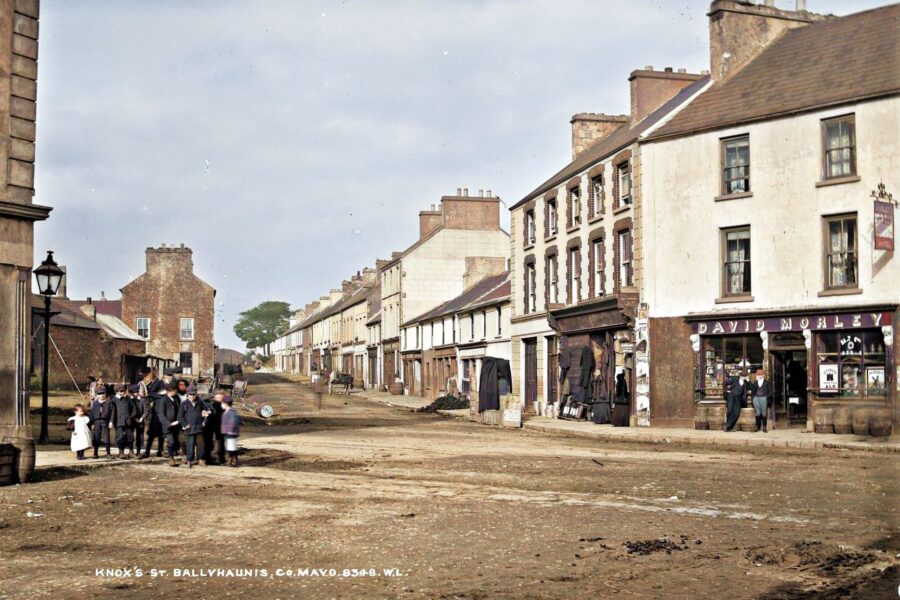
20th Century Ballyhaunis
The 20th century brought significant changes to Ballyhaunis, particularly in terms of economic development and demographic shifts. The town transformed from a primarily agricultural center to a more diverse, industrialized community with a unique multicultural character.
Industrialization
Ballyhaunis experienced a gradual but significant industrialization process throughout the 20th century:
Early Industries:
The century began with small-scale industries. In 1919, John Durkan and Sons Ltd established a wholesale bottling company, marking the start of industrial development.
Post-War Growth:
The post-World War II period saw accelerated industrial growth:
- 1948: James Connell founded a Wood Furniture Company
- 1949: Tom Donnellan established a Furniture and Coffin Company
- 1954: Austin Grogan and Sons Ltd started a Concrete Products Company
1960s Boom:
This decade saw further diversification of industries:
- 1960: D.K Moran founded a Furniture Company
- 1963: Western Chickens Ltd established a Poultry Processing Company
- 1967: Connacht Concrete Products Ltd was founded
1970s and Beyond:
The industrial base continued to expand:
- 1974: Halal Meat Packers Ltd opened a Meat Processing Plant
- 1977: Murphy Bros formed a General Engineering Company
- 1981: Farah Manufacturing Co. Ltd established a Slacks Company
Notably, furniture manufacturing became a significant industry in Ballyhaunis, with multiple companies established over the decades.
The establishment of poultry and meat processing plants, particularly the Halal Meat Packers, would prove significant for the town’s future demographic changes.
Population Changes and Immigration
Ballyhaunis underwent remarkable demographic shifts in the latter part of the 20th century. In the early 1900s, it was a relatively homogeneous Irish town, with the 1901 census recording a population of 3,056 in the Ballyhaunis area. However, like many rural Irish towns, Ballyhaunis likely experienced population decline in the mid-20th century due to emigration and urbanization.
The tide began to turn in the latter part of the century with the establishment of new industries, which helped to stabilize and then grow the population. A significant turning point came in 1974 with the establishment of the Halal Meat Packers, which attracted Muslim workers, primarily from Pakistan. This marked the beginning of Ballyhaunis’s transformation into one of Ireland’s most diverse towns.
By the end of the century, Ballyhaunis had become notably multicultural. The town saw the establishment of Ireland’s first purpose-built mosque outside Dublin, a testament to its growing Muslim community. Various immigrant communities, including Pakistani, Polish, and others, became integral parts of the town’s fabric, forever changing the cultural landscape of this small Irish town.
21st Century Demographics:
While outside our 20th-century focus, it’s worth noting that by the 2011 census, non-Irish nationals made up 42% of Ballyhaunis’s population, the highest proportion in Ireland.
The 20th century transformed Ballyhaunis from a traditional market town to a diverse, industrialized community. The establishment of various industries provided economic opportunities that not only retained local populations but also attracted immigrants from around the world. This laid the groundwork for Ballyhaunis to become a unique example of multiculturalism in rural Ireland in the 21st century.
Religious Heritage
Ballyhaunis has a rich and diverse religious heritage, with roots stretching back to the medieval period and evolving to reflect the town’s changing demographics in modern times.
St. Mary’s Abbey/Friary
Founding: St. Mary’s Augustinian Friary, often referred to as “the Abbey,” was founded in 1348 (though some sources suggest 1430) by Jordan Dubh Mac Costello. The friary played a crucial role in the town’s development, serving as a religious, educational, and social center for centuries.
The friary features notable architectural elements, including:
- A 15th-century main doorway with unique ornamentation
- A 15th-century window, which was lost for decades before being restored
- The high altar, moved to its present position in 1937
The church interior is rich in symbolism, including the Augustinian motto “Tolle Lege” (“Take and Read”) worked into a mosaic floor.
The friary boasts significant stained glass works, including:
- A window designed by Fr. Anderson OSA and constructed by Francis Barrett in 1878
- A Harry Clarke Studio window installed in 1937
Despite periods of suppression, the Augustinians maintained a presence in Ballyhaunis until 2002, when they withdrew due to falling vocations. The friary property was transferred to the Ballyhaunis Abbey Trust, ensuring its continued importance to the community.
Other Churches and the Mosque
Roman Catholic Churches:
Ballyhaunis has two Roman Catholic churches, reflecting its predominantly Catholic heritage:
- St. Patrick’s Parish Church, which is listed as a protected structure
- The details of the second church are not provided in the given information
Church of Ireland: While not explicitly mentioned in the provided information, many Irish towns of Ballyhaunis’s size would typically have a Church of Ireland presence.
Mosque:
Ballyhaunis is home to Ireland’s first purpose-built mosque outside of Dublin, a testament to the town’s growing Muslim population:
- The mosque’s establishment is linked to the arrival of Muslim workers, primarily from Pakistan, following the opening of the Halal Meat Packers plant in 1974.
- It serves as a religious and cultural center for the local Muslim community, which by 2016 comprised about 23% of the town’s population.
The presence of both long-established Christian churches and a relatively new mosque in a small Irish town makes Ballyhaunis a unique example of religious diversity in rural Ireland. The diverse religious institutions in Ballyhaunis not only serve spiritual needs but also play significant roles in maintaining cultural identities and fostering community integration.
Historically, religious institutions in Ballyhaunis, particularly the Augustinian friary, played crucial roles in education. While their direct involvement in education has decreased, they continue to contribute to the town’s cultural and social life.
Ballyhaunis’s religious heritage reflects its long history and its more recent demographic changes. From the medieval Augustinian friary to the modern mosque, the town’s religious institutions tell the story of a community that has maintained its traditional roots while embracing diversity and change. This unique religious landscape has become an integral part of Ballyhaunis’s identity and continues to shape the town’s social and cultural life.
Architecture and Protected Structures
Ballyhaunis boasts a rich architectural heritage that reflects its long history and development from a medieval religious settlement to a modern, multicultural town. Several buildings in the town are protected under Irish law, recognizing their historical and architectural significance.
Protected Structures
According to Mayo County Council, four buildings in Ballyhaunis are protected under Part IV of the Planning and Development Act 2000. These include:
- St Patrick’s Parish Church (Roman Catholic)
- The former St Joseph’s Convent
- St Mary’s Augustinian Friary
- The Ulster Bank
Notable People from Ballyhaunis
Despite its relatively small size, Ballyhaunis has produced or been associated with a number of notable individuals across various fields. These people have made significant contributions in areas such as sports, literature, politics, and the arts.
- Patrick Gallagher: Vietnam War hero.
- Frank Greally: Athlete, sports commentator, and founding editor of Irish Runner Magazine.
- Liam Harte: Author and university lecturer.
- John Heavey: Bishop of Cairns, Queensland, Australia (1941–1948).
- Jim Higgins: Member of the European Parliament.
- Keith Higgins: Full back on the senior Mayo football team and notable figure in Gaelic Athletic Association (GAA) sports.
- Anthony Jordan: Author and biographer contributing to Irish literature and historical documentation.
- Walter “Fulgentius” Jordan: Augustinian friar murdered by Cromwellian soldiers in 1649.
- Patrick Lyons: Antiquarian and Honorary Member of Royal Society of Antiquarians of Ireland.
- James McGarry: Biomedical engineering award winner contributing to medical science and technology.
- Maria McGarry: Classical pianist representing Ballyhaunis in the world of classical music.
- Bill Naughton: Playwright who wrote “Alfie” (1963), adapted into two films, significantly impacting British and Irish theatre and cinema.
- Matt Perry: Former England Rugby Union Fullback whose grandmother is from Ballyhaunis.
- Jean Butler: Irish dancer famous for Riverdance, whose mother Josephine is from Ballyhaunis.
Modern Ballyhaunis
Modern Ballyhaunis has emerged as a unique example of multiculturalism in rural Ireland, with a diverse population and an economy that blends traditional industries with newer enterprises.
Demographics and Multiculturalism
According to the 2016 Census, Ballyhaunis had a population of 2,312, and the town stands out for its remarkable diversity. Non-Irish nationals make up 42% of the population, the highest proportion of any town in Ireland and significantly higher than the national average. People from Poland and Pakistan form the largest immigrant groups, with the Muslim community being particularly significant – around 23% of the town’s population identified as Muslim as of 2016.
Ballyhaunis has become a model for integration in rural Ireland. It hosts Ireland’s first purpose-built mosque outside of Dublin, and local schools have adapted to serve a multicultural student body. This diversity has profoundly influenced local culture, cuisine, and community life, creating a unique blend of traditional Irish and international influences.
While the town’s diversity presents some integration challenges, it also offers opportunities for cultural exchange and economic links to other countries. Ballyhaunis’s experience demonstrates how a small Irish town can adapt to and benefit from global migration trends, becoming a microcosm of multicultural Ireland in the process.
Economy and Employment
Ballyhaunis’s economy in the modern era is diverse and evolving. Agriculture remains important, with farming still a significant source of employment, and the town continues its tradition as a market center, particularly for livestock. Several industries established in the 20th century continue to operate, including furniture manufacturing and food processing. Notably, the Halal meat processing plant, established in 1974, remains a significant employer and has played a key role in attracting immigrant workers.
As with many modern towns, the service sector in Ballyhaunis has grown, including retail, healthcare, and education. The town also has a variety of small and medium-sized enterprises, many catering to the diverse local population. Ballyhaunis’s unique multicultural character and historical sites, like St. Mary’s Friary, offer potential for cultural tourism.
However, like many rural Irish towns, Ballyhaunis faces challenges such as retaining young people and attracting new industries. The town must balance preserving its traditional character with embracing new economic opportunities. As Ballyhaunis moves further into the 21st century, its ability to leverage its diversity and blend traditional strengths with new opportunities will be key to its continued development and success.
Cultural Life
Ballyhaunis boasts a rich cultural life that reflects both its traditional Irish roots and its more recent multicultural character. This is particularly evident in its sporting traditions and local media.
Sports
Gaelic Athletic Association (GAA):
- Ballyhaunis GAA is the main sporting organization in the town.
- The club fields teams in both Gaelic football and hurling, representing the strong tradition of these sports in the area.
- Notable players like Keith Higgins, who played full back for the senior Mayo football team, have emerged from the local GAA scene.
Sporting Facilities:
The town boasts impressive sporting infrastructure for its size, including:
- Three GAA pitches
- Two football pitches
- Two rugby pitches
- A football astro pitch
- A football and basketball court
- A cricket training pitch
Multi-sport Culture:
- The variety of sports played in Ballyhaunis reflects its diverse population and the blending of traditional Irish sports with those popular in other cultures.
Media and Publications
Midwest Radio:
- This local radio station is based in Ballyhaunis.
- It serves Counties Mayo, Galway, Roscommon, Sligo, and Leitrim, making it a significant regional media outlet.
- The station also operates Midwest Irish Radio, a dedicated internet radio station.
Annagh Magazine:
- This annual publication has been a staple of Ballyhaunis cultural life since 1978.
- It appears each December, focusing on local interest stories.
- The magazine covers local events from the past year, as well as articles on Ballyhaunis history and culture.
- It was established by Ballyhaunis Junior Chamber and named after the local parish.
- The publication has adapted with the times, with all back issues now digitized and available online.


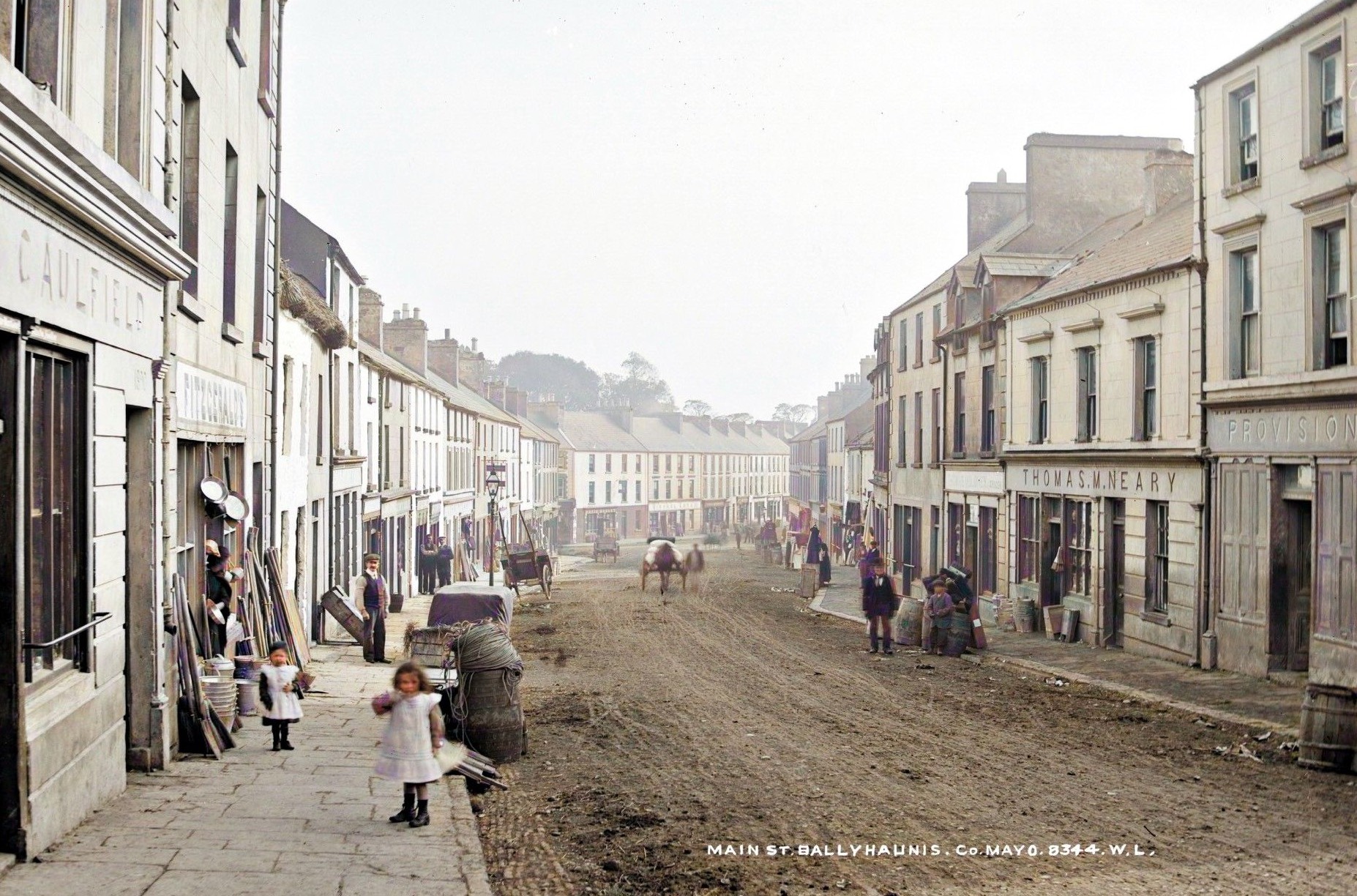

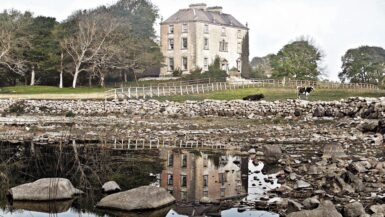
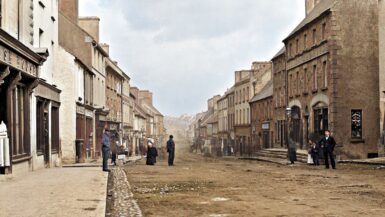
Leave a reply